Teltronic U PTMDT500760B Land-Mobile and/or Fixed Radio Transmitter and Receiver User Manual
Teltronic S.A.U. Land-Mobile and/or Fixed Radio Transmitter and Receiver Users Manual
Users Manual

User Guide
1
TABLE OF CONTENTS
1ABOUT THIS MANUAL ......................................... 5
2FOR YOUR SAFETY ............................................. 7
2.1 GENERAL .......................................................... 7
2.2 RF EXPOSURE REQUIREMENTS ......................... 8
2.3 ELECTROMAGNETIC COMPATIBILITY.................. 10
2.4 OTHER WARNINGS ........................................... 10
2.5 ANTENNA......................................................... 12
2.6 AUDIO ACCESSORIES ....................................... 12
2.7 MAINTENANCE ................................................. 12
3FIRST STEPS ...................................................... 14
3.1 START-UP ........................................................ 14
3.2 WORKING MODES. ........................................... 15
4BASIC USE.......................................................... 16
4.1 DISPLAY INDICATORS ....................................... 18
4.2 LED INDICATORS. ............................................ 20
4.3 LIST OF EDITABLE CHARACTERS ....................... 21
4.4 MAIN SCREEN .................................................. 22

User Guide
2
en
WASTE MANAGEMENT
The symbol means that the product must be taken to separate collection at the
product end-of life. Do not dispose of these products as unsorted municipal waste
PowerTrunk Inc. is the subsidiary of Teltronic S.A.U. responsible for business development,
distribution and customer support for Teltronic’s Land Mobile Radio products in North America.
The company is headquartered in New York City. Teltronic S.A.U. distributes the same
products for Land Mobile Radio under different trademarks and brand names in other regions
of the world.
Disclaimer
Although every reasonable effort has been made to ensure the accuracy of the information
contained herein and any other referred document, this should not be construed as a
commitment on the part of Teltronic S.A.U. and/or PowerTrunk Inc., and the liability of
Teltronic S.A.U. and/or PowerTrunk Inc. for any errors and omissions shall be limited to the
correction of such errors and omissions. Teltronic S.A.U. and/or PowerTrunk Inc. welcomes
any comment as a way to improve any delivered documentation.
The information contained herein has been prepared for the use of appropriately trained
personnel, and it is intended for the purpose of the agreement under which the information is
submitted. Any party using or relying upon this information assumes full responsibility for such
use and in no event shall Teltronic S.A.U. and/or PowerTrunk Inc. be liable to anyone for
especial, collateral, incidental, or consequential damages in connection with or arising out of
the use of this information.

User Manual
3
es
The information or statements given in these documents regarding the suitability, capacity or
performance of the mentioned hardware or software products cannot be considered binding
but shall be defined in the agreement made between Teltronic S.A.U. and/or PowerTrunk Inc.
and the customer.
Teltronic S.A.U. and/or PowerTrunk Inc. reserves the right to revise these documents and to
make changes to its content at any time, without prior notification.
Copyrights
No part of the information contained herein and the other referred documents may be copied,
distributed or transmitted by any means to any other party without prior written permission of
Teltronic S.A.U. and/or PowerTrunk Inc. The distribution of this document may be also
covered by NDA (non-disclosure agreement) between Teltronic S.A.U. and/or PowerTrunk Inc.
and the receiver.
Please also note that part of these contents even may be covered by patent rights.
This document, the referred documents and the described product are considered protected
by copyright according to the applicable laws.
PowerTrunk and the PowerTrunk logo are registered trademarks of Teltronic S.A.U.
Copyright © PowerTrunk Inc. All rights reserved.

User Guide
4
en
GUARANTEE
PowerTrunk Inc.. guarantees the replacement or repair, free of charge, of any products that
are found to have a manufacturing defect, in accordance with the general conditions of the
PowerTrunk Inc.. guarantee.
Under no circumstance shall PowerTrunk Inc.. be held responsible for problems or damage
caused by any accessory or auxiliary element that has not be supplied by or certified by
PowerTrunk Inc.. Neither shall PowerTrunk Inc.. guarantee the functioning of this product with
auxiliary equipment or accessories that have not been supplied or certified by PowerTrunk
Inc..

User Manual
5
es
1 ABOUT THIS MANUAL
Thank you for purchasing this PowerTrunk MDT-500 device.
The MDT-500 763-870 MHz can operate in the following frequency bands:
o 763-806 MHz
For Industry Canada, the frequency range is 768-776 MHz and 798-806 MHz.
For FCC, the frequency range is 769-775 MHz and 799-805 MHz.
o 806-870 MHz
For Industry Canada, the frequency range is 806-824 MHz and 851-869 MHz.
For FCC, the frequency range is 809-824 MHz and 854-869 MHz.
Frequency configuration is only allowed and controlled directly by the grantee (TELTRONIC,
S.A.U.).
Advanced services and a wide range of options and accessories will help you obtain the best
performance from mobile communications in your work.
This manual will show you how easy it is to use the main features of your new terminal. You
will learn how to make a group call, an individual call, how to send status message or how to
edit a text message and send it to one or several users.

User Guide
6
en
Before using the equipment, please read this manual carefully.
In addition to instructions on how to handle the device, you will also
find safety information, among which the international guidelines on
exposure to radio frequency.
Please keep this manual at hand for future reference. For further
information, contact your service provider.
At the end of this MDT-500 manual, you will find a Quick Reference Guide. In addition, each
unit is supplied with an Installation Guide.
Some functions described in this guide may depend on the configuration and options of the
equipment, as well as the firmware version.
Please, contact your service provider for more detailed information about the available
features of your equipment.

User Manual
7
es
2 FOR YOUR SAFETY
2.1 General
PowerTrunk has obtained official approval for a wide range of accessories for MDT-500
equipment: antennas, audio accessories, etc. These accessories have undergone all type of
tests to ensure their suitability and safety for the use they have been designed for, either
vehicle use (MDT-500). Use only PowerTrunk-approved accessories.
For your safety, only have your equipment and accessories repaired by personnel authorised
by PowerTrunk. An incorrect installation (MDT-500 Installation Guide) or repair could be
dangerous and will render your guarantee void.
The equipment has been designed to fulfil the applicable compliance regulations.
The equipment complies with Part 15 of the FCC Title 47 of the Code of Federal Regulations,
and with Industry Canada ICES-003. Operation is subject to the following two conditions: (1)
this device may not cause interference, and (2) this device must accept any interference,
including interference that may cause undesired operation of the device.
The equipment complies with the applicable Part 90 of the FCC Title 47 of the Code of Federal
Regulations, and the Industry Canada Regulation RSS-119.
The equipment is supplied with an identification label where the following IC Certificate
number and the FCC ID are displayed:
o FCC ID WT7PTMDT500760B
o IC 8624A-PTMDT760B
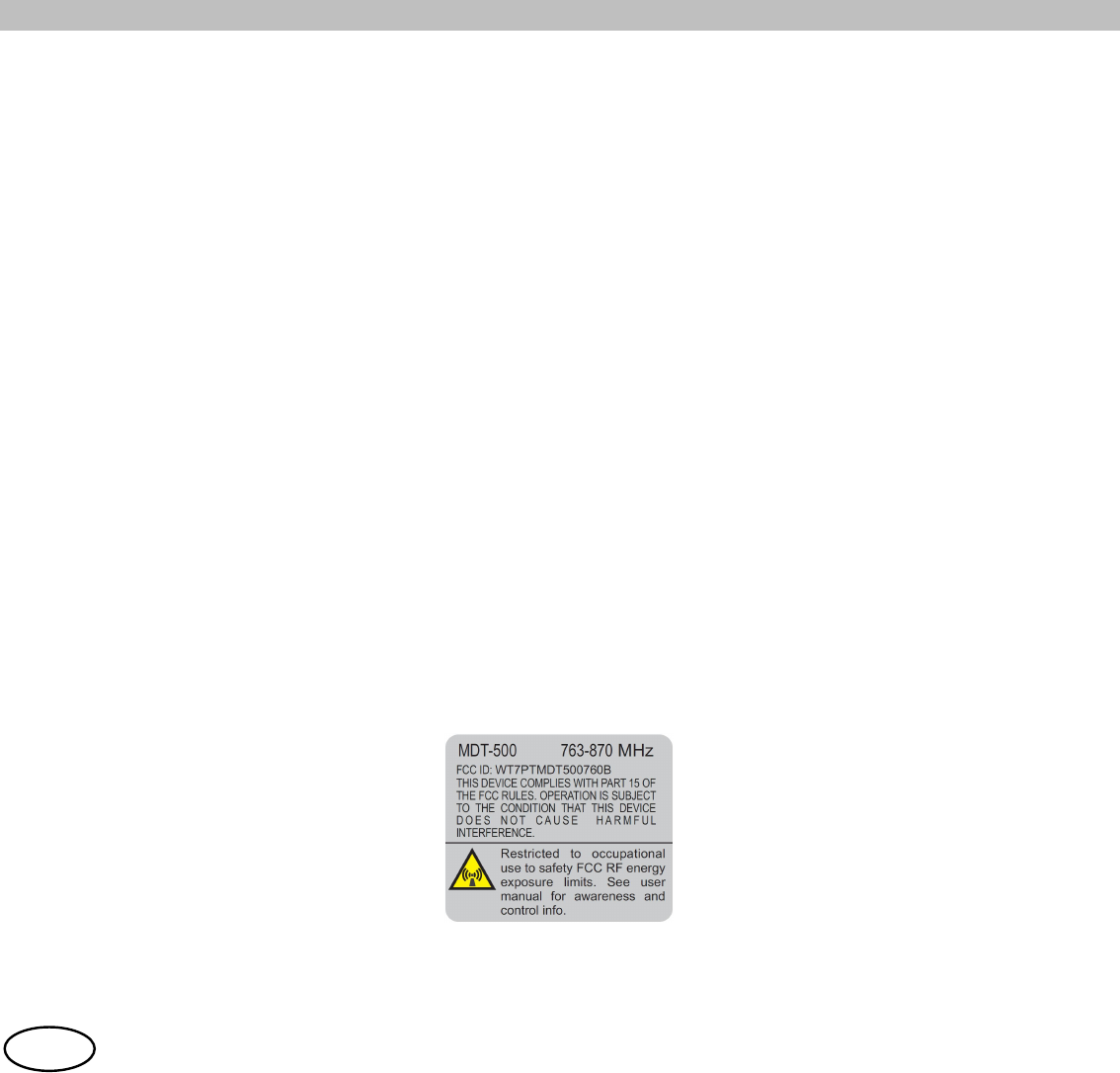
User Guide
8
en
Access scheme is Time division multiple access (TDMA) with 4 physical channels per RF
channel. RF Channel Bandwidth (Channel spacing) is 25 KHz. So, the equipment meets a
spectrum efficiency of one voice channel per 6.25 KHz of channel bandwidth.
Modulation scheme is /4-shifted Differential Quaternary Phase Shift Keying (/4-DQPSK)
with 18Ksym/sec. modulation rate, equivalent to 36Kbits/sec. So, the equipment meets a data
rate on each physical channel of 9000bits/sec. per 6.25 KHz of channel bandwidth.
Unapproved modifications or changes to this equipment may cause harmful interference
unless the modifications are expressly approved by PowerTrunk. In this case, the user could
lose the authority to operate with this equipment.
2.2 RF Exposure Requirements
Your MDT-500 equipment, together with the accessories for which PowerTrunk has obtained
official approval, have been designed and manufactured so that they do not exceed the limits
of exposure to radio frequency energy established in international guidelines.
These regulations, which are result of periodical scientific trials by independent organisations,
include a considerable safety margin, designed to guarantee the safety of all staff, regardless
of their age or state of health.
The following label will be placed in conspicuous view on the MDT-500:

User Manual
9
es
MDT-500 is restricted to occupational/controller use to safety RF
energy exposure limits. This radio is NOT authorized for general
population.
Use only accessories and antennas approved by PowerTrunk. Use
of non-approved accessories and antennas may exceed RF energy
exposure limits.
This device complies with the MPE requirements by providing a safe separation distance of
35cm between the antenna, which has a maximum gain of 15dBi, including any radiating
structure, and any person when normally operated.
Users can obtain Canadian information on RF exposure and compliance at the Industry
Canada RSS-102 standard text.

User Guide
10
en
2.3 Electromagnetic compatibility
The majority of electronic devices are susceptible to electromagnetic interference if they are
not adequately shielded, designed or configured for electromagnetic compatibility.
To avoid these compatibility conflicts, respect the current regulations of the area you are in,
and turn off the terminal whenever its use is prohibited, when it may cause interference or be
hazardous, for example, at hospitals or health care premises, where equipment sensitive to
external RF radiation may be being used.
Using two devices with antennas in close proximity may cause mutual interference. If this were
to occur, separate the antennas until the interference disappears.
2.4 Other warnings
High surface temperature
Warning: Burns may be suffered if the bare part of the antenna is
touched during radio equipment transmissions.
Long periods of transmission may cause the rear part of the
equipment, where the power amplifier radiator is located, to reach a
high temperature.
Vehicles
Vehicular Installation
The MDT-500 terminal must be supplied with a continuous nominal
12V voltage in equipment terminals (minimum 10.8V, maximum 15.6
V).

User Manual
11
es
RF signals may affect motor vehicles’ electronic systems if they are not properly installed or
well protected. For more information, check these aspects of your vehicle or the equipment
you have added with their manufacturers.
MDT-500 equipment has been approved in conformity with European Directive 95/54/CE to
guarantee safety in vehicle installations, due to radio equipment transmissions affecting the
vehicle’s electronic systems: electronic ignition systems, brake control (ABS), traction or
speed control and onboard computer systems.
For correct installation of the equipment, please follow the instructions given in the MDT-500
Installation Guide. Avoid using the area above the airbag or the area where it will inflate.
Airbags inflate with great force and the equipment could be projected forward and cause
serious injuries to vehicle occupants.
Potentially explosive environments
Disconnect the equipment when you are in an area with a potential explosion hazard and
comply with all notices and instructions.
Areas with a risk of explosions are often (although not always) indicated. Amongst these are
fuel filling areas (Ship decks, petrol stations, installations used for storing and transporting fuel
or chemical products) vehicles that use LPG and areas where the air contains particles such
as grain, powder or metal particles.
Sparks in these areas can cause explosions or fires, with the resulting risk of injury and even
death.
Driver safety
Check the laws and regulations on using mobile phones and radiotelephones in the area
where you are to drive and always abide by them. While driving, concentrate all your attention
on driving and always have your hands free to manoeuvre the vehicle.

User Guide
12
en
As a precautionary measure, whenever possible, park off the road to make or receive a call.
Programming
The equipment must always be programmed using a version of the programmer that is
compatible with the version of firmware.
2.5 Antenna
-Do not use the equipment without an antenna.
- To guarantee safety compliance, always use only antennas validated by PowerTrunk.
- Never use the equipment if the antenna is damaged. If a damaged antenna comes into
contact with the skin, it may cause burns.
2.6 Audio accessories
1. Only use accessories approved by PowerTrunk.
2. Follow the guidelines for fitting audio accessories in the MDT-500 Installation Guide.
2.7 Maintenance
The following recommendations will help you to increase the service life of the equipment and
maintain the guarantee coverage:
1. Do not install the equipment in dirty, damp or dusty locations. It is recommended to install
it out of direct sunlight and away from sources of heat. High temperatures can reduce
the service life of electronic components and deform or melt some plastics.
2. Any liquid spilt on the equipment can cause serious damage. If this occurs, consult your
authorised Technical Service.
3. Use a soft damp cloth for cleaning the outside surfaces. Never use chemical sprays or
abrasive cleaning products.

User Manual
13
es
4. Do not store the equipment in cold places. When the device warms up, there may be
condensation inside that could damage the electronic circuits.
5. Protect the equipment from impacts or being dropped. Circuit boards and more sensitive
mechanical components may get broken.
6. If you observe an error indication on the equipment screen that prevents it from working
normally, consult your service provider.
7. Do not open the equipment or try to modify it in any way. There are no user-serviceable
parts inside and removing the cover will expose you to electrical shocks and other
hazards. Any attempt to open the equipment and manipulate it in any way will render
your guarantee void.
8. Do not place heavy objects on the equipment or on its power cable. A damaged cable
could cause shocks or fires.
9. Only use the power cable supplied with the equipment.
10. Disconnect the equipment antenna when there are storms, to avoid lightening damage.
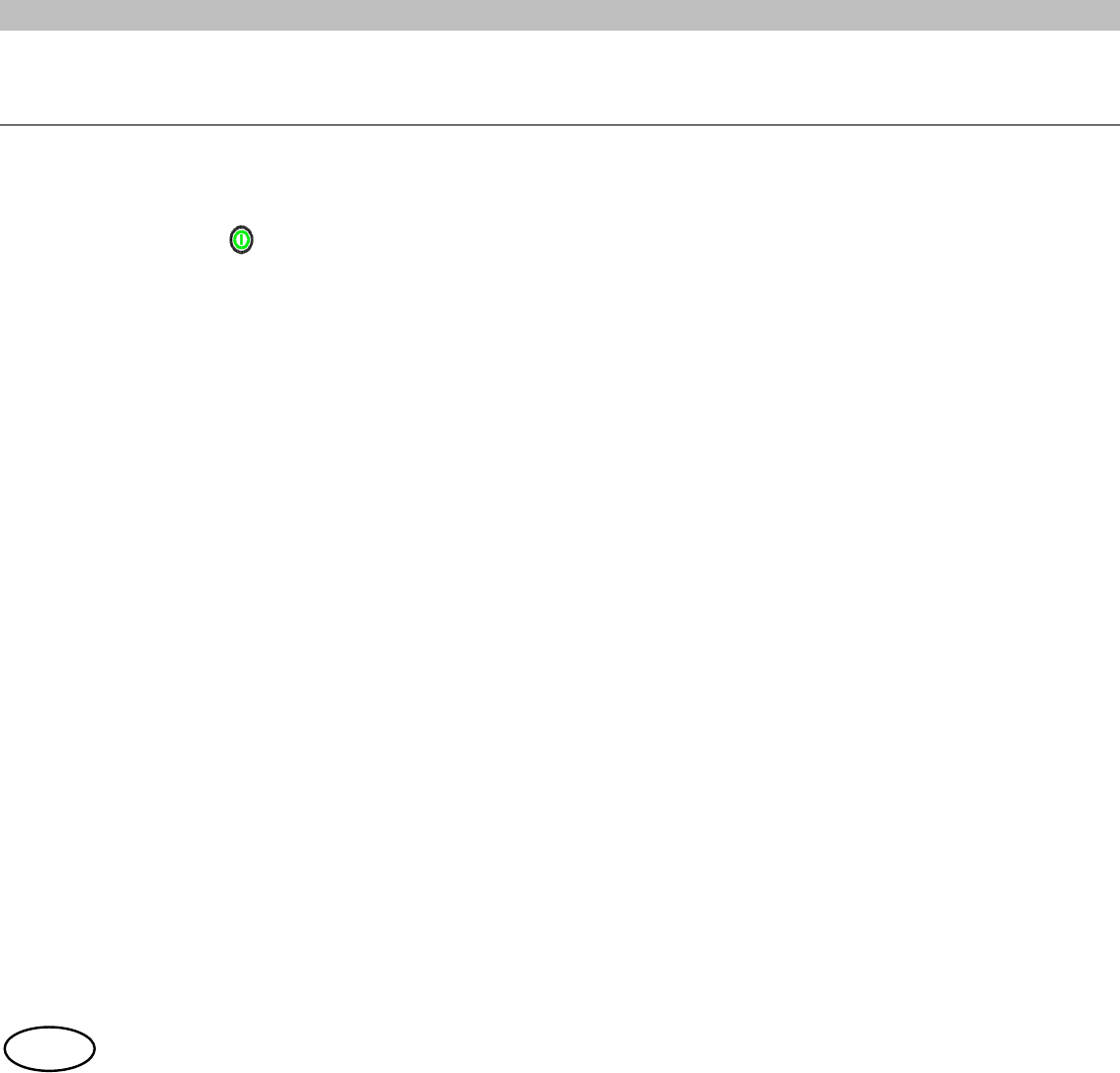
User Guide
14
en
3 FIRST STEPS
3.1 Start-up
1. Keep the key pressed to switch the equipment on or off.
2. On starting-up, it will display a welcome message (which can be configured by
programming). The software version of the equipment and the user’s name and address
will also be displayed for a few seconds.
3. If the equipment requests a PIN, enter the 4-digit code (by default the code is 0000),
which will appear on screen as ****, and press OK. It is recommended to change this
code for a safer one that you are able to remember.
4. If the user does not enter a correct PIN code after a number of permitted tries (which can
be configured, 3 attempts by default), the equipment will be locked until the personal
unlocking code - PUK - is entered (a 10-digit code). This code is provided by your Service
Provider.
5. When switching off the equipment, it will display a switch-off message and an acoustic
warning.
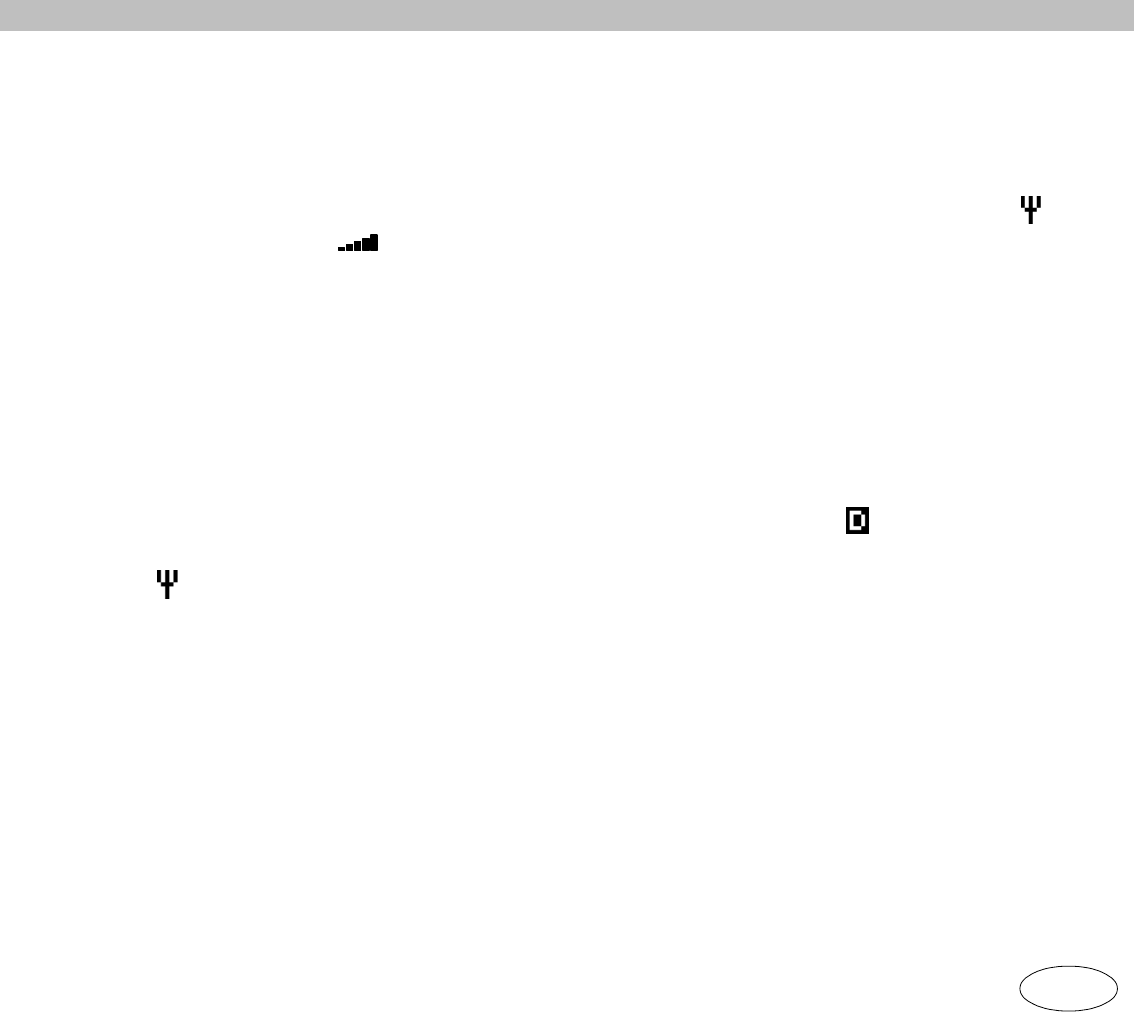
User Manual
15
es
3.2 Working modes.
6. There are three working modes: network mode (V+D), direct mode (DMO) and DMO-
GATE mode. In network mode (V+D), the equipment will be operational when the system
has been successfully registered. Then the display will show the symbols (Valid
network indicator) and (signal level indicator).
7. During the system registration and network access process, the SVC LED will be lit up
continuously in red, and when a valid network is found it will flash and try to register into
it. When the register is complete, a characteristic programmable acoustic signal will be
heard, the SVC LED will turn green and the screen will display the message “In service”.
If the equipment is unable to access a network, the display will show “No service” and the
SVC LED will stay red. Even if the equipment has not registered, it is possible to access
the Main Menu, to select the Direct working Mode, for example, without need for
infrastructure.
8. In DMO mode, the SVC LED will be green and the symbol (Direct mode active
indicator) will be displayed in the symbol line of the display (Upper line). In this mode, the
symbol (valid network indicator) is not displayed.
9. If the equipment has the DMO-GATE option available, this working mode can be
selected, which will enable the transfer of group calls from the network to terminals in
DMO mode and vice versa.
10. The equipment may be configured to start in any of the available modes or it is possible
to change the mode manually through the “Working modes” menu.

User Guide
16
en
4 BASIC USE
This manual is common for both equipment models: the MDT-500 mobile equipment and the
DT-410 office unit.
Both models have the same front panel, described below.
The MDT-500 can also be used without front for data applications using the PEI protocol and
audio control through the 600-ohm interface. If your equipment has this configuration, consult
with your Service Provider to learn about the services available and how to access them.

User Manual
17
es
No. Description Observations
1Microphone
connector
Connector for handheld Microphone or Micro-loudspeaker or
desktop microphone (DT-410).
Connector for the programming cable.
2Volume control Adjusts the volume level. Screen adjustment Contrast,
Volume audio and Volume tones.
3 Screen Alphanumeric display 4 x 16, line of symbols and line of ‘soft
keys’.
4STS LED Indicator Call status indicator.
5SVC LED Indicator Service indicator.
6ON/OFF key Key to switch on / off
7Navigation keys Navigation by menus/submenus and their options.
Editing phone books / messages.
8Alphanumeric
keyboard For entering number and characters. (See section 6.3)
9Emergency key Starts / cancels the emergency call.
10 Function key
Combined with other keys, it enables rapid access to certain
functions.
By continuous pressing, it changes the working mode
(V+D<-> DMO)
11 Menu key Access to Main Menu.
12 Soft keys Press to select the corresponding on-screen option.
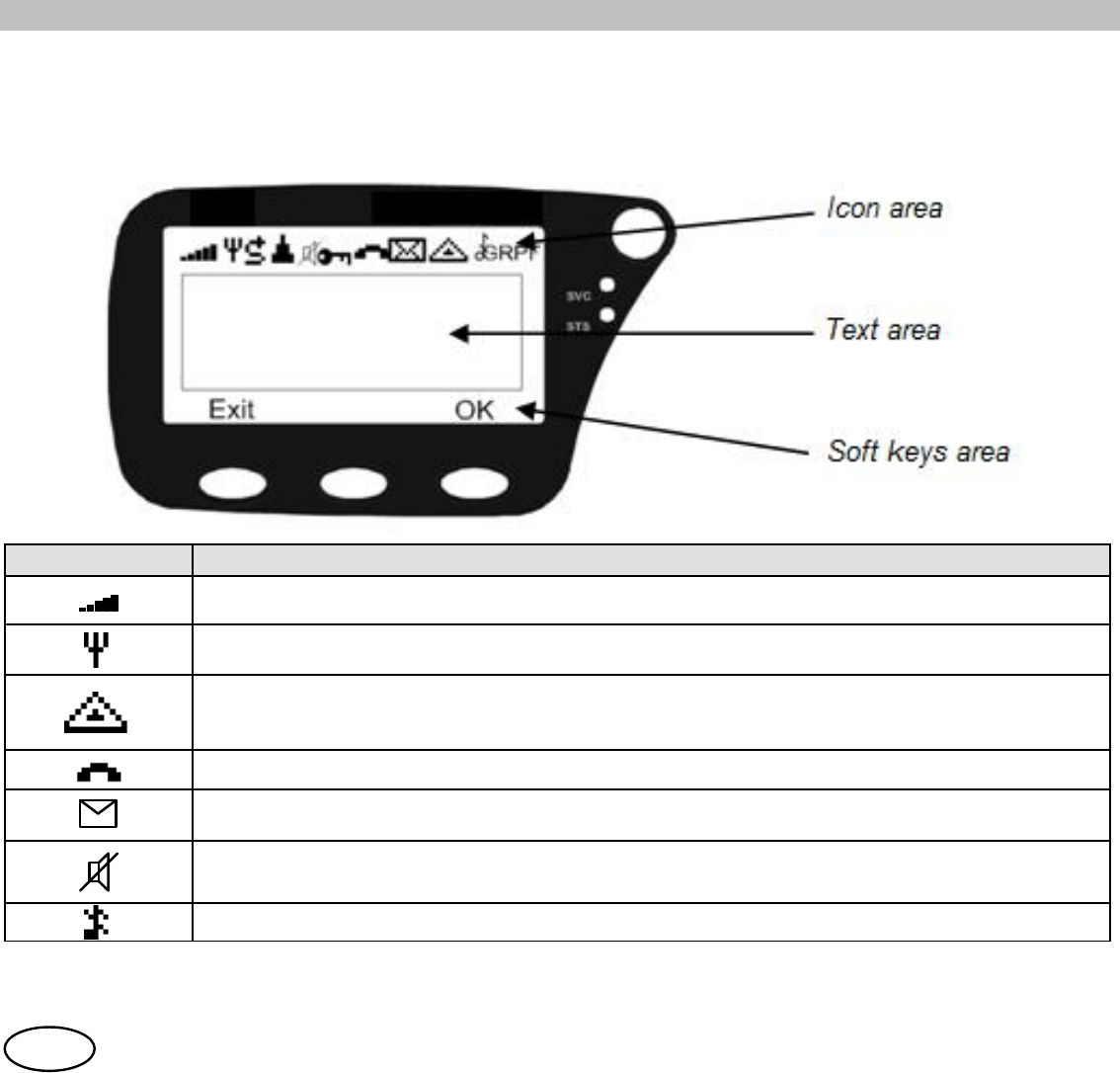
User Guide
18
en
4.1 Display indicators
The on-screen indicators display information about the operation of the equipment:
Symbol Description
Signal intensity (RSSI) or level of coverage indicator
Valid network (Only in V+D network mode)
Emergency call established (steady).
Flashing if the call is being set up.
Call established
Message received (steady). Flashing when a message is being sent.
Discrete mode active. Converts a semi-duplex incoming call with direct
signalling to on/off hook signalling.
All tones off
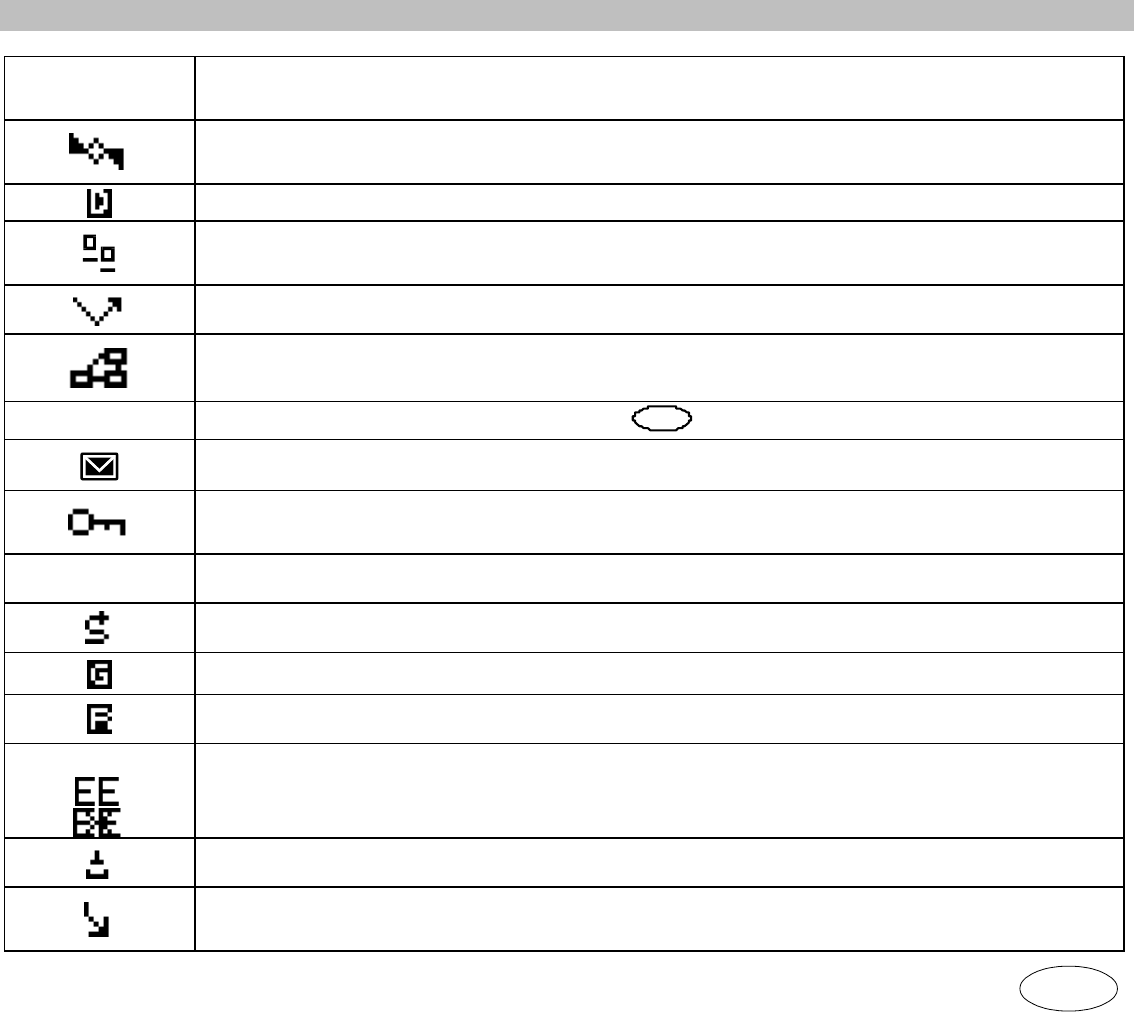
User Manual
19
es
GRP/BRD/P
RV/PHN/PBX Type of voice call selected: group (GRP), private (PRV), broadcast (BRD),
phone (PHN) or through telephone exchange (PBX).
GPS position valid (steady). Flashing if GPS position is not valid.
Will only be displayed if the GPS option is installed in the MDT-500 unit.
Direct mode (DMO) activated.
Data packet connection. Steay if the connection has been established.
Flashing if data transfer is under way.
Call diversion activated.
Inclusion call activated.
FAccess to sequential functions with
F
key.
Messages received box full
Steady: Terminal registered in encrypted mode. Encrypted call.
Flashing: Terminal registered in encrypted mode. Clear call.
ABC / abc Text editing screen
Active group scan (groups in listening mode).
DMO-GATE mode.
Presence of a DMO-REP detected in the DMO frequency selected.
When the terminal has the E2EE module (End to End Encryption) active:
Active call with E2EE Encryption.
Clear call active.
Migration. Terminal registered in a different network to its own local one.
TxI (Transmit Inhibit) functionality.
Transmissions temporarily inhibited (except emergency call).
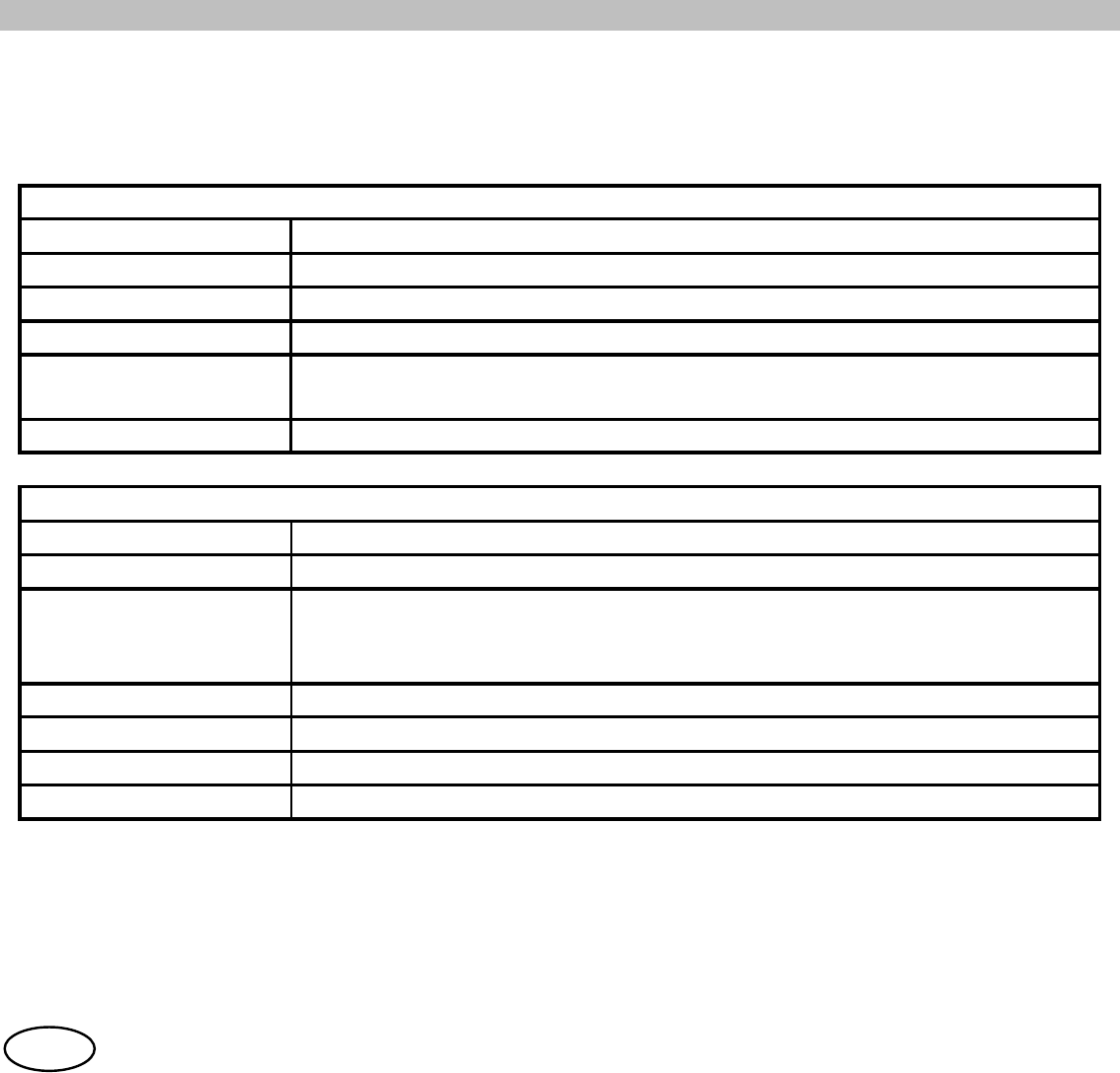
User Guide
20
en
4.2 LED Indicators.
LED indicators display information about equipment operation:
SVC LED
LED status Function
Off Equipment not operational.
Red Equipment not in service (no network registered).
Flashing red Equipment in the process of registering.
Green Equipment in service (Registered on the network).
Equipment operational (DMO).
Flashing orange Equipment in programming mode
STS LED
LED status Function
Off No call being carried out.
Red Equipment transmitting a call. PTT pressed (semi-duplex call) or
until the communication is over (duplex call, only in TMO –trunking
mode).
Flashing red Request or end of transmission.
Green Equipment receiving a call.
Flashing green Call in progress, no one transmitting.
Orange Call being established.
If the two LEDs (SVC and STS) are orange, this indicates an error. If this occurs consult your
Service Provider.
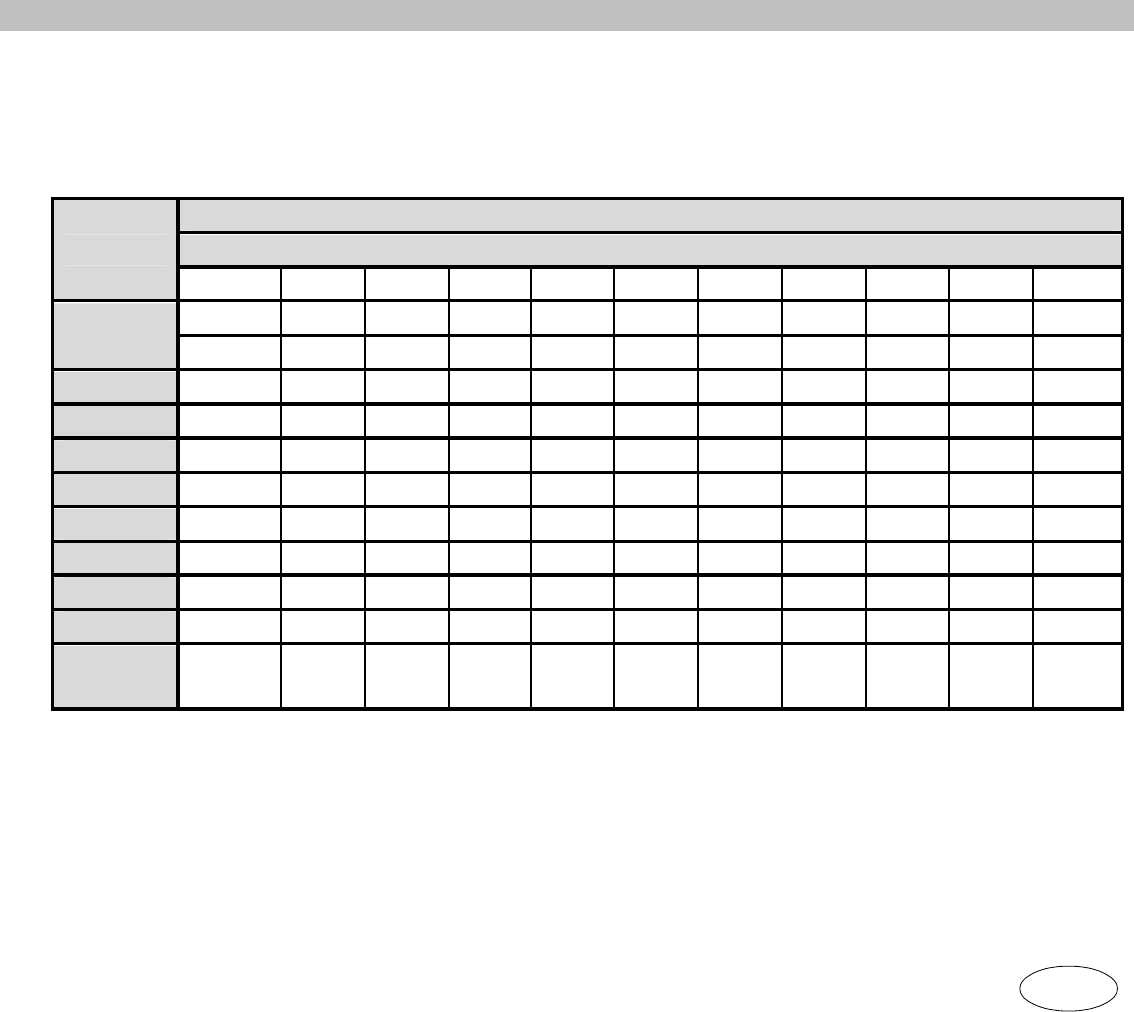
User Manual
21
es
4.3 List of editable characters
The following table displays the characters available for editing texts on the MDT-500 and DT-
410.
Keys
Screen characters
Number of times to press the key
1 2 3 4 5 6 7 8 9 10 11
1Space . 1 , & $ @ # ¿ ? ¡
! : ; _ “ ’
2 ABC A a B b C c 2 Á á À à Â â Ã ã Ä ä Å å Ç ç
3 DEF D d E e F f 3 É é È è Ê ê Ë ë
4 GHI G g H h I i 4 Í í Ì ì Î î Ï ï
5 JKL J j K k L l 5
6 MNO M m N n O o Ñ ñ 6 Ó ó Ò ò Ô ô Õ õ Ö ö
7 PQRS P p Q q R r S s 7
8 TUV T t U u V v 8 Ú ú Ù ù Û û Ü ü
9 WXYZ W w X x Y y Z z 9
0 + +
]-
{0
}=
<*
>÷ / \ ( ) [

User Guide
22
en
4.4 Main screen
The main screen is that of Voice Calls (in V+D network mode) – Group mode.
The equipment will be prepared to press PTT (Press-to-talk) and directly launch a call to the
group selected.
The basic information viewed on this screen consists of the range the selected group belongs
to, the name of the group and its status.
The soft key ‘Mode’ (Lower right-hand side of the screen) enables selection between other
types of call (private, telephone, PABX). If desired, automatic return to the preferred type of
call can be programmed after a few seconds.